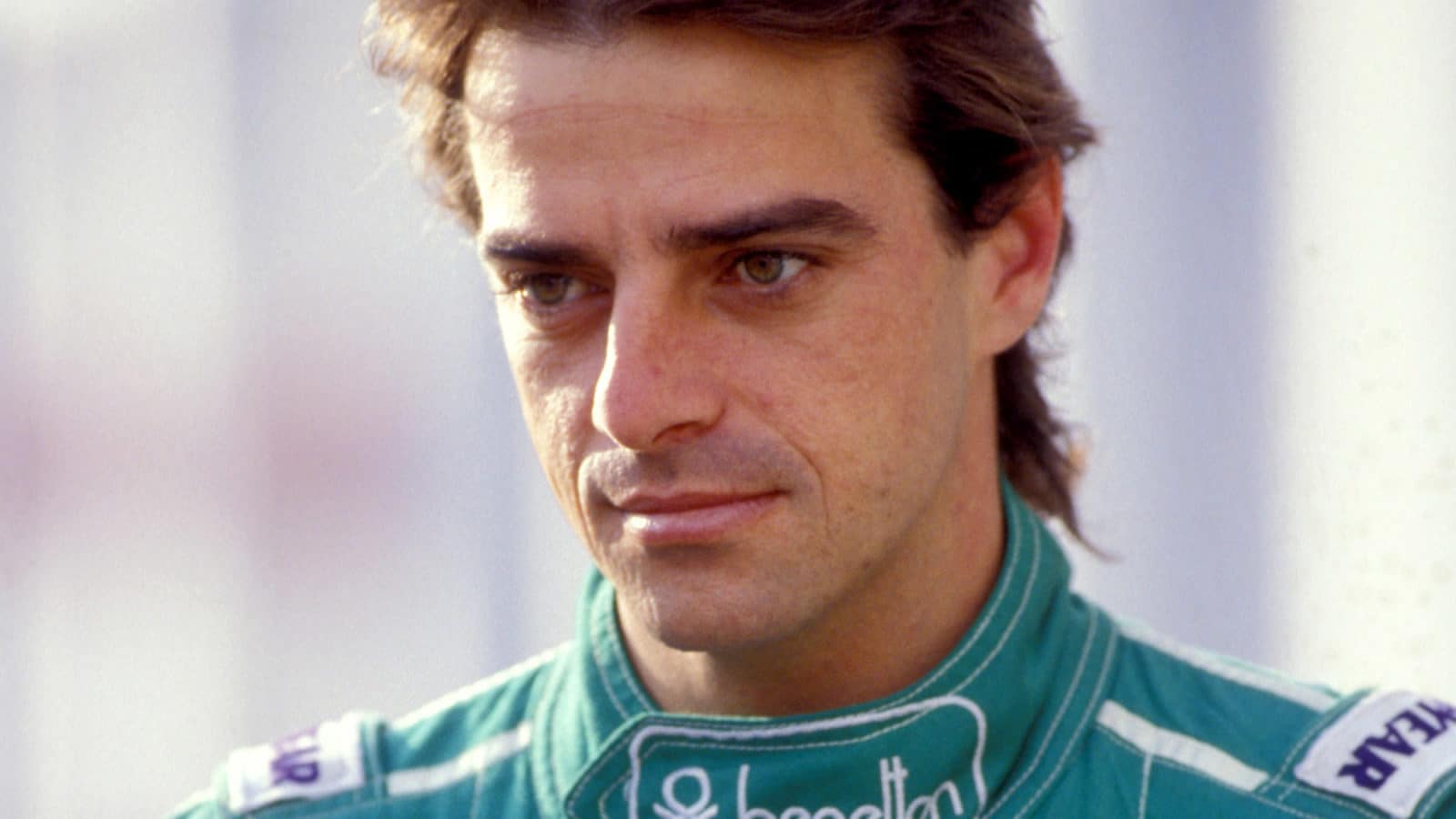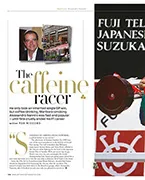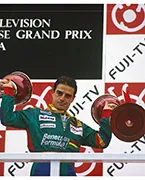With a year’s F2 experience behind him, some expected him to start winning races in ’83, but it didn’t happen, the highlight being a second place at the old Nürburgring. Over at Lancia, however, Sandro was still regarded as one of several hot Italian stars.
“I was the team leader,” recalls Riccardo Patrese, “and so Cesare Fiorio asked if I would be happy for the newcomer to drive with me. Sandro and I had a very good relationship from the start. He was a smooth driver and could go quickly without screwing the car.”
But motor racing was already well into the era where a driver could not rely on natural talent alone.
“I don’t think he had a lot of order in his life at that time,” Patrese says.”I said to him, ‘Look, you’ll have to work harder if you want to be a champion. You’re quick, but you need to discipline yourself from a physical and technical point of view. You need to work with the team, be more serious.”
The Patrese/Nannini combination ended 1984 with win at Kyalami. It was Sandro’s highlight of the year — his third F2 season a dispiriting water-treading affair. Minardi were about to make the leap into F1, but Sandro wouldn’t be going with them.
“Due to some reasons which were never clarified he didn’t get a Super-licence for 1985,” explains Giancarlo. “Instead, Pierluigi Martini got the drive and Sandro had to wait another year.”
Giancarlo kept the door open for him, though, and Nannini’s first year in F1 was an eye-opener — for him and the pundits. With the unreliable, gutless Motori Moderni turbo engine powering an update of Minardi’s ’85 car, Sandro achieved just one finish. At most grands prix, he was a spectator long before half-distance. But in qualifying he had proved the equal of Andrea de Cesaris, an established driver with a wild reputation, who could be very fast over a flying lap.
Nonetheless, it was the cashed-up de Cesaris who obtained a Brabham seat, while Nannini remained with Minardi for 1987, a decision Giancarlo believes was correct for both parties. The team was now relying on Sandro for results, and though finishes were in short supply (three to be exact), the M187 was at least a platform from which he could display his talent.
Minardi: “Every time he was out on the tack he was determined to surpass himself and to always improve his lap times. Sandro was never happy, never felt tamed, and sometimes went beyond even the team’s expectations.”
The result was six starts from the seventh row of the grid.
Benetton came calling…
As early as the second round of 1988, Nannini had justified this elevation, qualifying the Benetton-Ford fourth at Imola, beaten only by the McLaren-Hondas and Nelson Piquet’s Lotus. But it was clear that the Benetton, the most consistently quick of the normally-aspirated cars, was no match for the Honda turbos.
On raceday, Nannini and Belgian team-mate Thierry Boutsen battled with the Williams-Judds of Patrese and Mansell and, after some wild moments, Sandro finished sixth, his first championship point. Boutsen was fourth, and would have the edge at most races that season.
“Alessandro was a very naturally talented driver,” says Boutsen, “but he was not the best test driver. He usually copied my set-ups, which were not suitable for a single flying lap, but very good for the race. So that was one reason why I was always a bit faster in the race than him. The other reason was that fitness was not his good point He was smoking a lot and drinking coffee like crazy.”
Sandro’s first podium finish came at a rainswept Silverstone, after a big spin ended his tussle with Mansell’s Williams. His second top-three result came in the heat of Jerez, and that was less memorable for the simple reason that it was faultless.
The start of 1989 was a make-do time for Benetton. The new car was ready, but the more powerful Ford V8, around which it had been designed, was not. So the B188 with DFR motor was pressed into action for the first half of the season — and clearly Sandro missed his erstwhile team leader, now at Williams.
“A few times that season,” chuckles Boutsen, “he actually interrupted debriefs between Patrick Head and myself to ask what I would do with the B188 at that circuit.”
If the prospect of driving a year-old design had made Nannini complacent, he got a rude awakening at the Autodromo Nelson Piquet, when new team-mate Johnny Herbert, still recovering from almost losing his feet in that F3000 shunt, outqualified and outraced him.
“After the race I got back to the garage and Sandro had gone, Flavio Briatore had gone, and so had the entire Benetton family,” remembers Johnny. “Face to face, though, we never had a problem. He was a pretty nice guy, always smiling.”
On circuits where heavy braking was required, however, the hampered Johnny was nowhere and by midway through the season he’d been sacked. Nannini’s leadership was no longer under threat, and he scored a third place at Imola.
The B189 made its debut at Paul Ricard and Sandro ran second until its rear suspension collapsed. The combo’s promise was realised with a third at Silverstone, but the next six races raised just five points. It was a frustrating time, the McLaren-Hondas way out front, Ferrari and Williams about even on the next level, and the most Sandro could expect from qualifying was usually seventh. Sometimes, though, the Benetton’s lack of mechanical grip consigned him to the second half of the grid. At Jerez, he suffered the ignominy of lining up behind an Osella. Strange days.
On October 22, it got stranger still. A revised, more accelerative Ford pushed the No19 Benetton onto the third row at Suzuka, and although Sandro reverted to the standard engine for the race, he found himself running third. Unable to match the McLarens, he backed off to the tune of 1.5sec a lap.
Approaching the Casio chicane on lap 47, however, he saw Alain Prost’s McLaren up the escape road, minus its driver. Had he been made aware sooner that Senna had been delayed in an accident, he could have gone harder and probably stayed clear of the recovering Ayrton. Instead he was passed two laps from home, and crossed the line 2.3sec behind.
There was a delay before three drivers emerged on the podium. And none of them was Senna. As is now legend, Sandro climbed on the top step, flanked by Williams drivers.
The following race, after a torrential Adelaide storm, the same three drivers occupied the podium, Sandro second behind Boutsen.
Those 15 points elevated him to sixth in the championship, an improvement of three places over the previous season. It was a boost he would need for 1990, when he would be partnering a triple champion.
Nelson Piquet arrived at Benetton with a sullied reputation after two lacklustre years at Lotus. But Benetton felt they needed a big name and, in order to coax the best out of their new signing, put Piquet on a low-by-F1-standards basic salary bolstered by a huge wedge of dollars per championship point. It worked.
The B190 made its debut at the third round, and Sandro finished third, just six seconds behind the winner, Patrese, a superb drive. But not until the fifth round, Canada, did he outqualify Piquet; then, in a damp race, he crashed, while Nelson finished second.
“In the beginning, Sandro was a little bit shocked at Piquet’s speed,” recalls Flavio Briatore, Benetton team principal. “Nelson’s class was showing again. But then Sandro got the measure of him, and they became quite evenly matched.”
But not in terms of luck. At Paul Ricard, Nannini raced ahead of Mansell’s Ferrari and Senna until an engine failure cost him a certain third place. In the British Grand Prix a week later, he ran into the back of Patrese in his friend’s 200th grand prix.
Sandro passed Riccardo’s Williams properly in the German GP, but this time it was of far more significance. Benetton had decided to run non-stop, and when Senna emerged from the Hockenheim pitlane, he had to keep well over as Nannini hurtled past into the lead.
Over 16 laps, it became clear that Honda’s power advantage was not significant enough to breeze Ayrton into the lead, but the Brazilian eventually hassled Nannini into a mistake under braking for a chicane.
“We were quick,” says Briatore, “but Honda’s acceleration was so strong and Senna was driving, so… We never really expected to win there. Second place was still good, you know.”
Elation turned to anger in the next race, Hungary. Right behind Boutsen’s leading Williams, with 14 laps to go, Nannini was the quickest man on the track, seeking a place to pass.
“My car was extremely wide,” says Thierry. “My only way to win was to stay on worn tyres, not make a pitstop. I knew, with my Renault engine, no-one could pass me down the straights, and the corners are too tight to pass. There is no chance he would have passed me.”
The matter was made academic when Senna knocked the Benetton into the air, and a very upset Nannini retired with damaged suspension.
Sandro channelled his anger into something constructive. At Spa, the Benetton team again elected to go without a pitstop, and Sandro had a resolute, wheel-banging battle with the McLaren of Berger for third. It was resolved in the Austrian’s favour just three laps from the end when worn tyres gave Sandro a heart-stopping, tail-out moment on the exit of Eau Rouge, losing him crucial momentum up the long hill to Les Combes.
At Monza, unreliability lost him sixth place; at Estoril, he finished on Piquet’s tail; then came that third place in Jerez; then… Then he was ‘gone’.
The cruel irony was not lost when Nelson won the final two races of the year. Either, or both, of those wins could have gone Sandro’s way, so sparkling had been his form. It was no surprise that Ferrari had shown an interest in him.
Briatore: “Alessandro was very open, very correct with us. When Ferrari weren’t sure what Jean Alesi would be doing for ’91 he had signed for three or four teams we had gone to discuss things with Cesare Fiorio. But you know, I think Sandro was happy where he was, and was worried about the pressure he might find as an Italian in Ferrari.”
That he was able to return to motor racing in 1992 was a tribute to the doctors who worked on his arm in those desperate hours, days, after the helicopter accident. That he wanted to is a tribute to his passion for the sport.
His Fl days, however, were over.
What might have been?
“Sandro had a hell of a lot of talent,” says Herbert. “If he had found Benetton-style mental support at a better team, I think he could have achieved some very good results.”
Patrese is less sure: “Sandro was fast, but in F1 that’s not enough. You have to build everything around you: you must be good in testing, you must be number one, you must have your hands on problems and carry them to the top to get them sorted. I don’t know if he could do this.”
Boutsen is sure he couldn’t: “He could drive a car with three wheels as quick as when it had four, but he was not a worker, not a test driver. He was fast enough to win more races, but a champion? No. He was just a good, fun guy living life at 100 per cent.” Not a world champion then, but the best, surely, was still to come.



